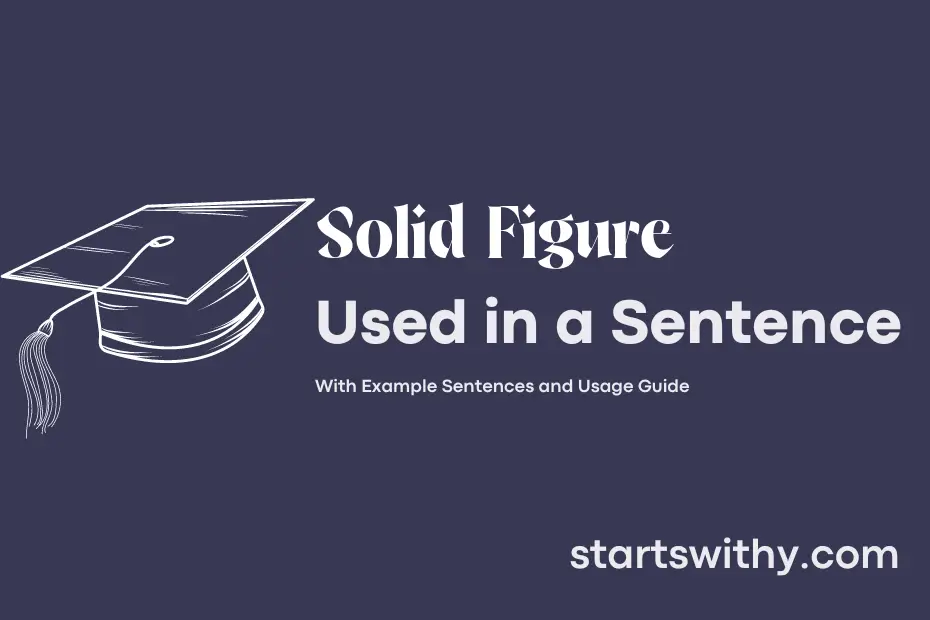Do you ever find yourself struggling to differentiate between two-dimensional shapes and three-dimensional shapes? One concept that can help clarify this distinction is the idea of solid figures. A solid figure is a three-dimensional shape that occupies space and has volume.
7 Examples Of Solid Figure Used In a Sentence For Kids
- A cube is a solid figure with six equal square faces.
- A cylinder is a solid figure with two circular faces and one curved surface.
- A cone is a solid figure with a circular base and one curved surface.
- A sphere is a solid figure with no edges or vertices, perfectly round.
- A pyramid is a solid figure with a polygon base and triangular faces meeting at a point.
- A rectangular prism is a solid figure with six faces, all rectangles.
- A triangular prism is a solid figure with a triangle base and three rectangular faces.
14 Sentences with Solid Figure Examples
- Solid figures are an important topic in geometry that students often struggle with.
- Understanding the properties and formulas of different solid figures is crucial for success in engineering.
- The professor asked us to calculate the volume of a specific solid figure for our assignment.
- In our mathematics class, we learned how to find the surface area of various solid figures.
- The student used a 3D printer to create a model of a solid figure for their science project.
- The college library has a collection of books on geometry that cover different types of solid figures.
- Solving problems related to solid figures requires a good understanding of mathematical concepts.
- The engineering students used CAD software to design solid figures for their project.
- The college workshop had a session on 3D modeling, where we learned how to create different solid figures.
- The student presentation on the importance of solid figures in architecture was both informative and engaging.
- A thorough understanding of the properties of solid figures is necessary for a career in civil engineering.
- The physics lab had a hands-on activity where students had to measure the density of a specific solid figure.
- The math club organized a workshop to help students visualize and manipulate solid figures in a virtual environment.
- The final exam included a question that required students to identify the type of solid figure based on its characteristics.
How To Use Solid Figure in Sentences?
To use the term “Solid Figure” in a sentence, you need to understand its meaning and how it relates to geometry.
In geometry, a solid figure refers to a three-dimensional shape that occupies space. Common examples of solid figures include cubes, spheres, cones, and cylinders. When using the term in a sentence, it is important to properly identify the specific shape you are referring to.
For example, you could say, “The toy car is in the shape of a solid cube,” where solid emphasizes that it is not a flat drawing, and cube specifies the particular type of solid figure.
When using the term solid figure, consider its physical characteristics and how it differs from two-dimensional shapes like circles or squares. This distinction helps convey the shape’s overall volume and dimensions.
As you practice using solid figure in sentences, remember to provide context and descriptive details to enhance your meaning. Whether discussing objects in real life or solving geometry problems, a clear understanding of solid figures is crucial for effective communication.
Conclusion
In this article, we explored how sentences with solid figures can be used to describe shapes such as cubes, spheres, and pyramids. These sentences help provide clear and vivid descriptions of physical objects with defined boundaries and surfaces. By incorporating words that convey the characteristics of solid figures, such as “cuboid,” “spherical,” and “tetrahedral,” writers can create imagery that helps readers visualize the shapes being described.
Whether in a math problem, a technical description, or a creative piece of writing, sentences with solid figures are valuable tools for effectively communicating information about shapes and structures. By mastering the use of these descriptive terms, writers can enhance the precision and clarity of their writing, enabling readers to grasp the physical attributes of various solid figures with ease.



